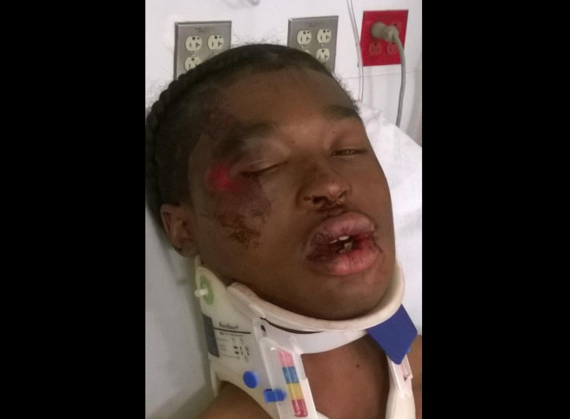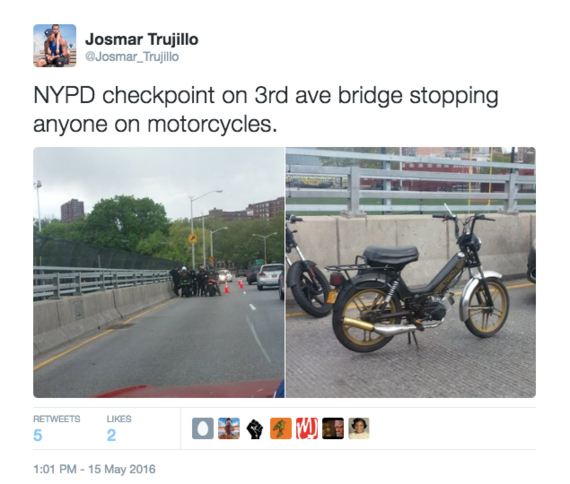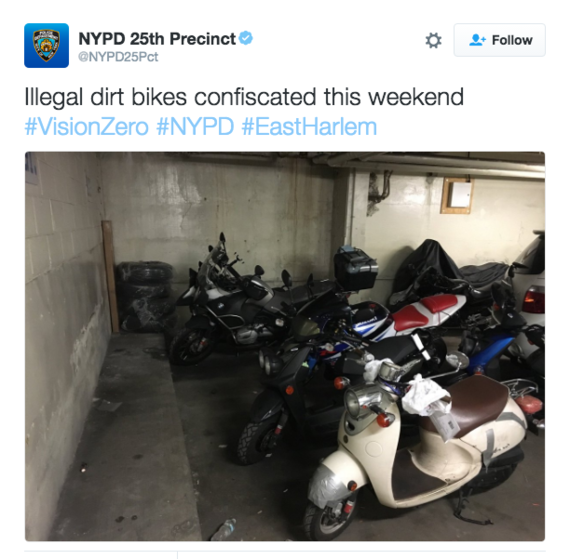
"I was devastated. I screamed. All I could think of was that the morgue was at King's County. I was thinking the worst."
That was Linda Joyner's reaction when she saw her son after a terrible motorcycle accident back in April. Yousef, who'd just turned 18, was riding a dirt bike in the Bed-Stuy part of Brooklyn when he crashed into a pedestrian on Lafayette Avenue. Yousef was seriously injured, scraping the skin off of his face and needing surgery to wire his jaw shut. The pedestrian was also seriously injured.
Yousef had been hit from behind, he says, by a police car.
An NYPD cruiser had followed he and his friends north on Lewis Avenue for blocks, Yousef told me, before pulling alongside him and swerving in his direction, trying to scare him. Yousef describes feeling the bump of the police car ram his bike, forcing him to lose control. He struck a pedestrian, who apparently may have not been crossing with the light, and blacked out. When he came to he remembers a cop pushing him back onto the floor as he tried to get up. He was handcuffed and sent to the hospital, where he stayed cuffed to the bed. Cops charged him reckless driving and driving without a permit.
For safety concerns, the police department says that it has no-chase policy in regard to illegal dirt bikes and ATV's but videos and accounts from riders tell a different story. In March, video taken by an ATV rider in the Bronx captured a cop chasing and pointing a gun at him. In 2015, video contradicted the police version of a deadly 2012 accident where a police cruiser hit a biker from behind, killing one man and leaving another with brain damage.
Around that same time another Bronx man was killed in another in a case where police chased and hit Eddie Fernandez while he was also riding a dirt bike. The city had to shell out $250,000 to that Fernandez's friend, Adalberto Gonzalez, who saw his friend die and who was injured and arrested for riding another bike. "I am glad that I can now get on with my life," Gonzalez told the Daily News. "But what upsets me is that these cops have gotten away with it and they won't stop."
Although a Civilian Complaint Review Board investigation substantiated claims of misconduct by the police officers involved, determining that cops had not only repeatedly hit the dirt bike but had also made false statements, neither of the cops were disciplined. One of the officers, Fernando Santos, was promoted to Sergeant.
"I think NYPD is outta control with everything they do and how they handle situations," Yousef's mother says. "If there's a no-chase policy why was [Yousef] chased? "Why do I have to worry about my son being hurt by the NYPD?", she asks. After getting little to no answers from police officials from the 81st precinct shortly after Yousef's accident, Joyner is as frustrated as ever. "The level of respect between them and us is out of control. They have no respect."
In May, NYPD commissioner Bratton held a press conference to show confiscated dirt bikes and ATV's being crushed by bulldozers. Droves of reporters showed up to cover what was, explicitly, a public relations stunt. Bratton wanted to show, in a crudely symbolic way, that the police were going to be as aggressive as possible to combat a perceived illegal motorcycle menace. But not everyone one is as vehemently opposed to dirt bike riders. In many neighborhoods across the city, the bikes, though illegal, give young men of color an outlet that is not necessarily putting lives in danger. Most people in my neighborhood don't even bat an eye when riders zip up and down the street in large numbers.
"Everything we do, people of color, is problem," Joyner says. Though her son's bike is illegal, she notes that there are no places for he and his friends to ride like there are in other states. To chase them through the streets like violent criminals is a complete waste of time and resources, she says. "With all the things going on, this has to be an issue? You mean to tell me you got time for this? And then to run him down like he's an animal? That reminds me of animals in the wild--cornering them."
Yousef was charged with reckless driving and riding without a permit, but his story may be just another flashpoint in an escalating war against dirt bikes, ATV's and even delivery scooters and legal motorcycles. The Third Avenue bridge, which connects the South Bronx and East Harlem, is often the site of police checkpoints specifically set up to stop motorcycles, including street legal vehicles. On various occasions I've driven and seen police detaining any number of motorcycle riders trying to enter Manhattan. Last month in the Upper East Side, police were grabbing small scooters, parked on 1st Avenue, and putting them in the back of NYPD trucks. These were scooters almost assuredly belonging to delivery workers.
Part of the NYPD's crackdowns are attributable to the city's "Vision Zero" traffic initiative, which seeks to reduce traffic-related deaths. The police department has noted that their aggressive efforts against illegal bikes are part of that strategy. The numbers, however, on fatalities related to dirt bikes or ATV's is slim. Again, last year there were none. Dirt bikes are most often young black and Hispanic men. Deliverymen are often people of color, oftentimes undocumented immigrants. So why start the crackdowns now?
Mayor Bill de Blasio has repeatedly said that the Vision Zero is part and parcel of Broken Windows policing, a controversial low-level enforcement philosophy which has come under scrutiny by activists and protesters the last few years. While promoting safety is a laudable goal, empowering the police department, which has long history of racially-disprportionate enforcement, to make that happen isn't a good idea.
In fact, history says that letting the police genie out of the bottle to make the streets safe brings with it little hope that you can ever hope to put that genie, one donning a gun and a badge, back in. There was a time when tactics like Stop and Frisk were seen as efficient ways to get guns off the street. When the police department abused that authority and stopped Millions of innocent people, it took many years and multiple court challenges to walk those numbers back.

 Yousef after the accident (Photo: Linda Joyner)
Yousef after the accident (Photo: Linda Joyner) Bratton and NYPD Chief Carlos Gomez walking by confiscated dirt bikes and ATV's before they were demolished in a police PR stunt back in May
Bratton and NYPD Chief Carlos Gomez walking by confiscated dirt bikes and ATV's before they were demolished in a police PR stunt back in May
